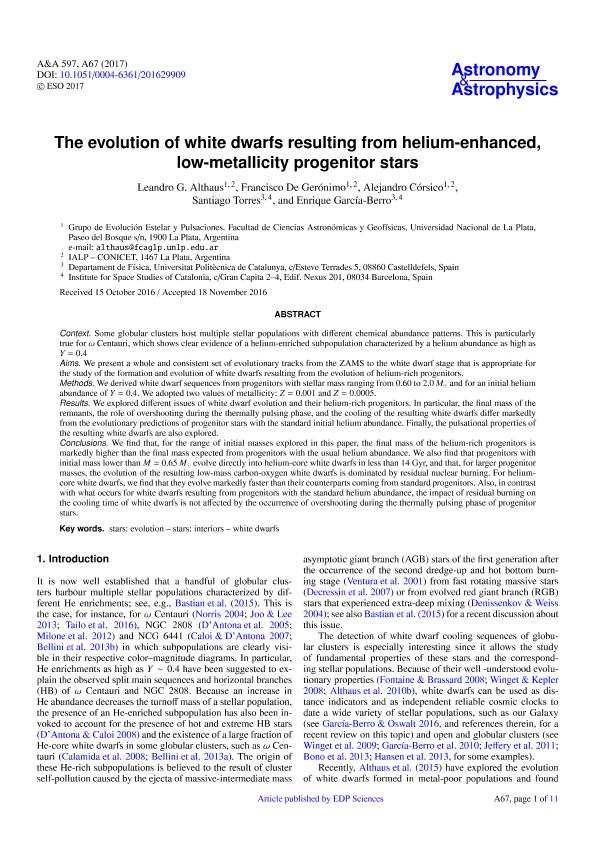Mostrar el registro sencillo del ítem
dc.contributor.author
Althaus, Leandro Gabriel

dc.contributor.author
de Gerónimo, Francisco César

dc.contributor.author
Corsico, Alejandro Hugo

dc.contributor.author
Torres, Santiago
dc.contributor.author
García Berro, Enrique

dc.date.available
2018-04-06T14:03:19Z
dc.date.issued
2017-01
dc.identifier.citation
Althaus, Leandro Gabriel; de Gerónimo, Francisco César; Corsico, Alejandro Hugo; Torres, Santiago; García Berro, Enrique; The evolution of white dwarfs resulting from helium-enhanced, low-metallicity progenitor stars; EDP Sciences; Astronomy and Astrophysics; 597; 1-2017; A67
dc.identifier.issn
0004-6361
dc.identifier.uri
http://hdl.handle.net/11336/41060
dc.description.abstract
Context. Some globular clusters host multiple stellar populations with different chemical abundance patterns. This is particularly true for ω Centauri, which shows clear evidence of a helium-enriched subpopulation characterized by a helium abundance as high as Y = 0.4Aims. We present a whole and consistent set of evolutionary tracks from the ZAMS to the white dwarf stage that is appropriate for the study of the formation and evolution of white dwarfs resulting from the evolution of helium-rich progenitors.Methods. We derived white dwarf sequences from progenitors with stellar mass ranging from 0.60 to 2.0 M⊙ and for an initial helium abundance of Y = 0.4. We adopted two values of metallicity: Z = 0.001 and Z = 0.0005.Results. We explored different issues of white dwarf evolution and their helium-rich progenitors. In particular, the final mass of the remnants, the role of overshooting during the thermally pulsing phase, and the cooling of the resulting white dwarfs differ markedly from the evolutionary predictions of progenitor stars with the standard initial helium abundance. Finally, the pulsational properties of the resulting white dwarfs are also explored.Conclusions. We find that, for the range of initial masses explored in this paper, the final mass of the helium-rich progenitors is markedly higher than the final mass expected from progenitors with the usual helium abundance. We also find that progenitors with initial mass lower than M ≃ 0.65 M⊙ evolve directly into helium-core white dwarfs in less than 14 Gyr, and that, for larger progenitor masses, the evolution of the resulting low-mass carbon-oxygen white dwarfs is dominated by residual nuclear burning. For helium-core white dwarfs, we find that they evolve markedly faster than their counterparts coming from standard progenitors. Also, in contrast with what occurs for white dwarfs resulting from progenitors with the standard helium abundance, the impact of residual burning on the cooling time of white dwarfs is not affected by the occurrence of overshooting during the thermally pulsing phase of progenitor stars.
dc.format
application/pdf
dc.language.iso
eng
dc.publisher
EDP Sciences

dc.rights
info:eu-repo/semantics/openAccess
dc.rights.uri
https://creativecommons.org/licenses/by-nc-sa/2.5/ar/
dc.subject
Evolution of Stars
dc.subject
Interior Stars
dc.subject
White Dwarfs
dc.subject.classification
Astronomía

dc.subject.classification
Ciencias Físicas

dc.subject.classification
CIENCIAS NATURALES Y EXACTAS

dc.title
The evolution of white dwarfs resulting from helium-enhanced, low-metallicity progenitor stars
dc.type
info:eu-repo/semantics/article
dc.type
info:ar-repo/semantics/artículo
dc.type
info:eu-repo/semantics/publishedVersion
dc.date.updated
2018-03-26T14:37:55Z
dc.journal.volume
597
dc.journal.pagination
A67
dc.journal.pais
Francia

dc.journal.ciudad
Paris
dc.description.fil
Fil: Althaus, Leandro Gabriel. Consejo Nacional de Investigaciones Científicas y Técnicas. Centro Científico Tecnológico Conicet - La Plata. Instituto de Astrofísica La Plata. Universidad Nacional de La Plata. Facultad de Ciencias Astronómicas y Geofísicas. Instituto de Astrofísica La Plata; Argentina. Universidad Nacional de La Plata. Facultad de Ciencias Astronómicas y Geofísicas; Argentina
dc.description.fil
Fil: de Gerónimo, Francisco César. Consejo Nacional de Investigaciones Científicas y Técnicas. Centro Científico Tecnológico Conicet - La Plata. Instituto de Astrofísica La Plata. Universidad Nacional de La Plata. Facultad de Ciencias Astronómicas y Geofísicas. Instituto de Astrofísica La Plata; Argentina. Universidad Nacional de La Plata. Facultad de Ciencias Astronómicas y Geofísicas; Argentina
dc.description.fil
Fil: Corsico, Alejandro Hugo. Consejo Nacional de Investigaciones Científicas y Técnicas. Centro Científico Tecnológico Conicet - La Plata. Instituto de Astrofísica La Plata. Universidad Nacional de La Plata. Facultad de Ciencias Astronómicas y Geofísicas. Instituto de Astrofísica La Plata; Argentina. Universidad Nacional de La Plata. Facultad de Ciencias Astronómicas y Geofísicas; Argentina
dc.description.fil
Fil: Torres, Santiago. Universidad Politécnica de Catalunya. Departament de Física Enginyeria; España
dc.description.fil
Fil: García Berro, Enrique. Universidad Politécnica de Catalunya. Departament de Física Enginyeria; España
dc.journal.title
Astronomy and Astrophysics

dc.relation.alternativeid
info:eu-repo/semantics/altIdentifier/doi/http://dx.doi.org/10.1051/0004-6361/201629909
dc.relation.alternativeid
info:eu-repo/semantics/altIdentifier/url/https://www.aanda.org/articles/aa/abs/2017/01/aa29909-16/aa29909-16.html
Archivos asociados
